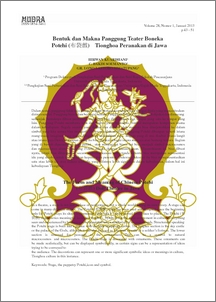Hirwan , Kuardhani and C. Bakdi , Soemanto and G.R Lono , Lastoro Simatupang
(2013)
THE FORM AND MEANING OF CHINESE POTEHI (布袋戲) DOLL THEATRE IN JAVA.
Mudra (JURNAL SENI BUDAYA), 28 (1).
p. 1.
ISSN 0854-3461
![[img]](http://repo.isi-dps.ac.id/style/images/fileicons/application_pdf.png)  Preview |
|
PDF (THE FORM AND MEANING OF CHINESE POTEHI (布袋戲) DOLL THEATRE IN JAVA)
- Published Version
Download (380kB)
| Preview
|
Abstract
In a theatre, a stage is not just a place of performance but a whole world telling its own strory. A stage can come in many different shapes. The Potehi (布袋戲) stage has been used and designed since the beginning only for Potehi plays its shape is permanent, although it can be moved from place to place. The Potehi (布 袋戲) stage carries meaningful icons and symbols. Symbols are the main component in culture. Everything seen and experienced by humans can be translated into a symbol all of us understands. Structurally speaking
the Potehi stage is built like a palace with devided imaginary rooms. The heigher section is the sky castle
or the palace of the Gods, although it can also be used as a human’s castle or a soldier’s fortress. The lower section is reserved for peasants or the commoners. This can be a symbol to natural macrocosmos and microcosmos. The Potehi stage is decorated with ornaments. These ornaments can be made realistically, but can be displayed symbolically, as certain signs can be a representation of ideas trying to be conveyed to the audience. The decorations can represent one or more significant symbolic ideas or meanings in culture, Tionghoa culture in this instance.
Keywords: Stage, the puppetry Potehi,icon and symbol.
Actions (login required)
 |
View Item |


